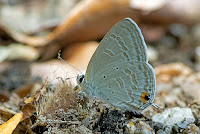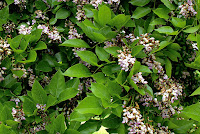<> Catochrysops strabo (Fabricius, 1793) <>
the Forget-me-Not ผีเสื้อฟ้าดอกถั่วธรรมดา
Click on any photo to see all photos full size in Lightbox
Additions and corrections to the information provided on this page is always welcome. Please use the Contact form.

Photo taken at Lamnamkok National Park, Chiang Rai, Thailand 450m a.s.l.

Catochrysops strabo is widely distributed across the whole of the SE Asia region and is quite common in many areas. Although the underside of both sexes is similar the upperside of the wings is quite different. The male is light blue with a black eyespot at the tornus of each hindwing while the female has a wide light brown/grey border around both sets of wings plus other markings and an orange and black eyespot on the hindwings. The females are rarely seen and are very difficult to photograph while the males, although very active are regularly seen puddling at the side of streams. It is a sun lover and prefers open areas within and around the forest. It flies low, just a metre or so above the ground, in a fast and rather erratic fashion. Males are often seen circling the larval food plant in search of females.
The species is multivoltine and having a relatively short lifecycle produces multiple generations each year. The adult female lays her eggs on the the flower buds of the host plant.
Synonyms and previously used names: Hesperia strabo, Lycaena asoka, Lycaena tejua, Lycaena didda, Lycaena kandarpa
Taxonomy: Animalia - Arthropoda - Insecta - Lepidoptera - Lycaenidae - Polyommatinae - Catochrysops - strabo
Regional subspecies: Catochrysops strabo celebensis (Indonesia), Catochrysops strabo luzonensis (Philippines), Catochrysops strabo strabo (India, Myanmar, Thailand, Laos, Cambodia, Vietnam, S.China, W.Malaysia, Singapore).
Regional Distribution: Nepal, Bhutan, India, Bangladesh, Myanmar, Thailand, Laos, Cambodia, Vietnam, China, Taiwan, Malaysia, Singapore, Indonesia, Philippines
 |
Doi Suthep-Pui National Park, Chiang Mai, Thailand 400m a.s.l. |
Habitat: Catochrysops strabo is found in open areas within lowland and montane deciduous forest, forest edges, scrubland, and wasteland. Seen mostly at lower elevations but has been recorded up to around 1900m a.s.l.
Flight time: most of the year depending on location Wingspan: 24-30mm
Life History: egg 3-4 days instar 1 3 days instar 2 3 days instar 3 3 days instar 4 4-5 days instar 5 3 days pupa 7-9 days Total egg to adult 26-30 days
All times are approximate and can vary depending on the season and on the host used.
Larval Hosts: Abrus precatorius, Butea monosperma, Cajanus cajan, Dunbaria punctata, Dunbaria villosa, Flemingia lineata, Flemingia strobilifera, Grona heterocarpos, Grona heterophylla, Lablab purpureus, Lathyrus oleraceus, Neustanthus phaseoloides, Ougeinia oojeinensis, Paracalyx scariosus, Phyllodium elegans, Phyllodium longipes, Phyllodium pulchellum, Pongamia pinnata, Rhynchosia cana, Tephrosia purpurea, Tephrosia villosa, Trifolium repens, Vigna radiata, Vigna unguiculata (Fabaceae), Allophylus cobbe, Schleichera oleosa (Sapindaceae).
Actual host plant used depends upon location and availabilty of plant species.
Adult Food Sources: Nectar - Acmella paniculata, Chromolaena odorata, Tridax procumbens (Asteraceae), Gomphrena globosa, Celosia argentea (Amaranthaceae), Berberis napaulensis (Berberidaceae), Alnus nepalensis (Betulaceae), Gentiana capitata (Gentianaceae), Magnolia campbellii (Magnoliaceae), Actinidia strigosa (Actinidiaceae), Vaccinium vacciniaceum (Ericaceae), Kaempferia rotunda (Zingiberaceae), Lantana camara (Verbenaceae), Leea indica (Vitaceae), Pogostemon benghalensis (Lamiaceae). Other - mud puddling, animal dung.
 |
| Chiang Dao Wildlife Sanctuary, Chiang Mai, Thailand |
 |
| Lamnamkok National Park, Chiang Rai, Thailand |
 |
| Doi Suthep-Pui National Park, Chiang Mai, Thailand |
 |
| Doi Suthep-Pui National Park, Chiang Mai, Thailand |
 |
| Lamnamkok National Park, Chiang Rai, Thailand ♂ |
 |
| Kaempferia rotunda, a nectar source |
 |
| Magnolia campbellii, another nectar source |
 |
| Doi Suthep-Pui National Park, Chiang Mai, Thailand |
 |
| Doi Suthep-Pui National Park, Chiang Mai, Thailand |
 |
| Phyllodium pulchellum, a larval host |
 |
| Pongamia pinnata, another larval host |
Links to other pages in this series for species in the same subfamily
